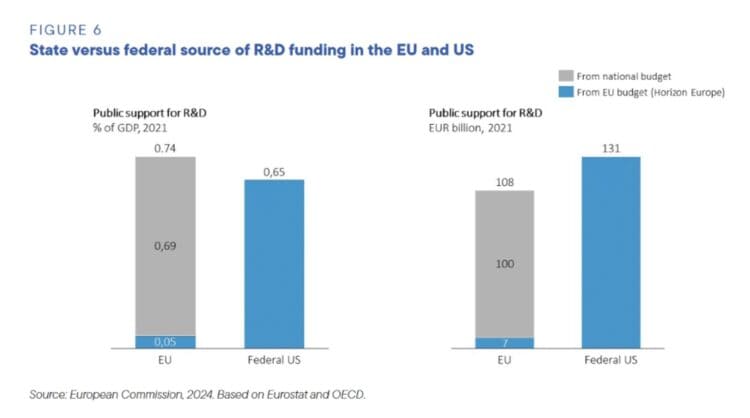Research and Innovation (R&I) have traditionally been considered pivotal to Europe’s future growth strategy. Since the Lisbon summit in 2000, the European Commission (EC) has promoted growth policies intended to be smart—yielding high value-added and productivity; sustainable—such as the European Green Deal aimed at achieving the Paris climate targets; and inclusive—enhancing not only the income conditions of European citizens but also their individual welfare and well-being. It is, therefore, unsurprising that recent policy reports comissioned by the EC on the future of the single market—the Letta report—and on the future of competitiveness—the Draghi report—have once again underscored the critical importance of R&I for Europe’s future prosperity.
What is surprising, however, is that despite the growth and “consolidation” of the European R&I system over recent decades, supported by stronger legal foundations in various treaties, its impact on European productivity and competitiveness has, as Draghi observes, become “stuck.” Over the past two decades, Europe appears to have been caught in an “innovation gap” or “mid-tech trap,” with productivity growth lagging behind the United States and China. Draghi highlights that “on a per capita basis, real disposable income has grown almost twice as much in the US as in the EU since 2000.” In both the US and China, corporate investment in R&I significantly exceeds that of Europe, resulting in markedly higher productivity growth, start-up rates, and new business activity. While EU labour productivity caught up with the US between 1950 and 1995, it lost momentum between 1995 and 2010 and has since grown only on par with US productivity but at a lower overall level. Commentators on the Draghi report have pointed out that Europe’s relative decline in competitiveness has been obscured by what might be described as European “economic somnolence.” How so?
Firstly, previous competitive growth engines, such as the automotive industry, have lost steam. Europe’s automotive sector had established itself as a producer of high-quality, technologically sophisticated premium goods with secure export markets. However, new opportunities in green and digital transformation have primarily benefitted foreign competitors due to regulatory frameworks offering single market advantages to these external players. Secondly, Europe’s reliance on cheap Russian oil and gas sustained the competitiveness of its large, energy-intensive industries, such as chemicals. This access enabled incremental CO2 reductions within the framework of the EU’s Emissions Trading System, which was laden with exemptions and free allowances, delaying systemic transformation. Finally, the “peace dividend” allowed many European countries to redirect funds into social welfare systems, as European treaties prohibited EU funding for military purposes. This restriction not only stymied the development of a competitive European defence industry but also limited technological breakthroughs due to a lack of opportunities for scaling and procurement. Unsurprisingly, the Draghi report identifies these three areas as priorities for bold reforms in EU policymaking.
The first aspect Draghi addressed is the “innovation gap” in the emerging growth areas of the 21st century, particularly digitalisation and Artificial Intelligence (AI). The second is the “competitiveness gap,” exacerbated by higher energy prices that undermine industrial decarbonisation efforts. The third is the “security gap,” reflecting the vulnerabilities of Europe’s open trade and investment model. To address these challenges, the Draghi report advocates for a “new industrial strategy” centred on closing the innovation gap, formulating a joint plan for decarbonisation and competitiveness, and enhancing security while reducing dependencies. The implications for European Research and Innovation (R&I) policy deriving from Draghi’s analysis warrant closer examination. Three critical aspects stand out.
First, as highlighted in the Draghi report, the multi-level governance structure of R&I divided between Member States and the EC inherently results in the fragmentation of research activities across Europe. Figure 6 from the Draghi report illustrates this point clearly.

According to Draghi, “Public R&D spending in the EU is highly fragmented across Member States, not consistently directed towards EU-wide priorities, and often difficult to access. In the US, the vast majority of public R&D spending comes from the federal budget. In the EU, it largely comes from the budgets of the 27 Member States, complemented by a smaller amount of EU-level resources. R&D spending at the EU level mostly comes from Horizon Europe, the EU’s Framework Programme for R&I. Other EU-level resources come from the structural and cohesion funds and the European Defence Fund. All the EU-level funding of public R&D accounts for around one-tenth of the overall public spending on R&D in the Union.”
This fragmentation has led to calls for increased European R&I funding, with Draghi recommending an allocation of 200 billion euros over seven years. Similarly, the more recent Heitor report on the next Framework Programme advocates for “increased, better focused and ring-fenced funding across the full spectrum of R&D&I,” proposing a budget of 220 billion euros. However, even if these funding increases were realised, they would not address the core issue of fragmentation. Translating these proposals into Figure 6’s context, EU public funding for R&D would rise to approximately 30 billion euros annually—a total comparable to US federal funding. Yet this would do little to solve the underlying governance challenges identified by both Draghi and Heitor.
A more radical proposal is required. Revisiting ideas proposed at the Lisbon Summit in 2000 offers a pathway forward. Simplifying the multi-level governance of R&I could begin with making fundamental research the primary responsibility of the European Commission. This could involve integrating Member States’ funding for national research councils into the European Research Council (ERC) and expanding this to include all national plans and investments in public R&D. These national plans, given their long-term impact, could be excluded from the semester assessments of Member States’ fiscal deficits, effectively exempting them from the three percent deficit criterion under the Maastricht fiscal rules.
Additionally, budget proposals by Member States that foresee reductions in public R&D should not count toward fulfilling fiscal deficit criteria. This approach, originally proposed by Commissioner Busquin at the Lisbon Summit, was dismissed at the time due to concerns about the Euro’s stability. However, in today’s context of multi-crisis budgetary pressures and the need for increased public investment in sustainability and security, a renewed attempt to exempt research funding is both timely and necessary.
Second, the Draghi report underscores the rapid widening of the innovation gap between the US and Europe over the past decade. Experts attribute this to structural issues within the European innovation system, particularly regarding risk-taking, entrepreneurship, and the availability of venture capital. As Jacques Pelkmans observes, “It’s about (…) greater risk-taking in the EU rather than risk-avoidance. It’s about ways to become more innovative, to help innovators become true investors that will spur EU economic growth and generate real benefits for the entire EU market. It’s about the benefits of having EU countries working more closely together, in designing financing methods and new funds that make a new and more daring form of entrepreneurship in Europe possible that removes the allure of the financiers across the Atlantic.”
The Draghi report also highlights Europe’s missed opportunities in digitalisation, particularly the dominance of US platform firms that have optimally exploited the harmonisation of the European single market. This raises the question of whether earlier European industrial policies, particularly in microelectronics and ICT, focused on the wrong priorities. The liberalisation of national telecom markets, for example, occurred at the expense of creating a common European telecom market. While the EU initially led in emerging mobile telephony markets, it subsequently failed to capitalise on digitalisation. However, the EU’s current lag in digital services provision does not preclude it from taking the lead in the next wave of digitalisation, particularly in areas such as AI.
AI development could be anchored in local technological expertise and driven by demand for GovTech within the EU’s multi-governance framework. Regulatory frameworks, often seen as barriers to growth, could instead create opportunities for innovation. For instance, Europe’s multilingual environment could stimulate AI solutions in media, education, and communication, while cross-border regulatory differences in healthcare, education, energy, and taxation could become opportunities for efficiency and innovation with the help of AI. The next phase of digitalisation offers a unique opportunity for the EU to overcome inefficiencies and transform competitiveness in traditionally non-tradable sectors, boosting regional and national economic performance.
Third, both the Letta and Draghi reports introduce security as a new dimension of European challenges in light of rising geopolitical tensions. As Rainer Kattel and I argue, the EU must develop a coherent approach to security investments that aligns with its green and digital agendas. Addressing this requires fundamental shifts in the EU’s main funding programmes: the Framework Programmes for R&I and the cohesion funds.
In R&I policy, the current shared parallel competence structure allows Member States to conduct national research policies independently of the EU. This governance framework could be expanded to explicitly include defence-focused research, creating a European Defence Research and Innovation Area (EDRIA). Meanwhile, cohesion policy, described by Rainer Kattel and myself as Europe’s “secret weapon,” could integrate security considerations into regional development strategies. Given the geographical overlap between military facilities and cohesion regions, such an approach could express European solidarity while addressing regional imbalances. As we note, these shifts would enable market expansion and integration in defence-related expenditures, advance green and digital growth agendas, and incorporate territorial development goals into defence programmes.
In summary, while the EU has lagged behind the US and China in reaping the benefits of R&I, the challenges for the new European Commission are clear: fundamentally reform R&I funding, dismantle barriers to innovation, and prioritise security investments as a cornerstone of European citizens’ well-being.
This article is part of the Project “EU Forward” Social Europe runs in cooperation with the Friedrich-Ebert-Stiftung.
Luc Soete, emeritus professor at Maastricht University and member of the Royal Dutch Academy of Arts and Sciences, holds an economics degree from Ghent University and a PhD from the University of Sussex. He founded the Maastricht Economic Research Institute on Innovation and Technology (MERIT) in 1988 and directed it until 2012. He later served as Rector Magnificus of Maastricht University (2012–2016) and Dean of the Brussels School of Governance (2019–2023).

